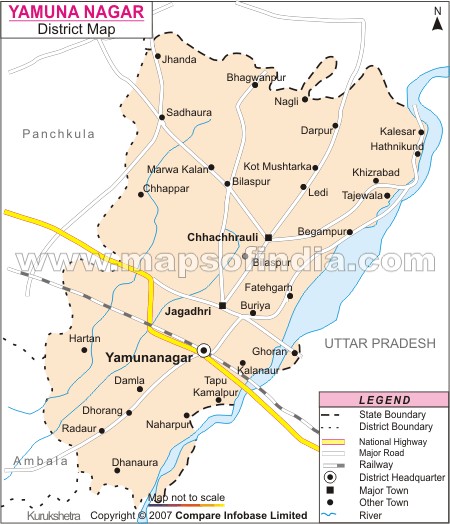Sugh

Sugh is a village in tahsil Jagadhari of Yamunanagar district in Haryana.
Hstory
It was known as Srughna or Sugh in ancient times and was an old Capital of Ancient Punjab.[1]
Probable age of the Stupa of Bharhut
The probable age of the Stupa which Cunningham has assigned to the Asoka period or somewhere between 250 and 200 B.C. Bharhut was on the high road between Ujjain and Bhilsa in the south, and Kosambi and Sravasti in the north, as well as Pataliputra in the east. On this line at a place called Rupnath, only 60 miles from Bharhut, there is a rock inscription of Asoka himself. As he was governor of Ujjain during his father's lifetime Asoka must often have passed along this road, on which it seems only natural to find the Stupas of Bhilsa, the rock inscription of Rupnath, the Stupa of Bharhut, and the Pillar of Prayaga or Allahabad ; of which two are actual records of his own, while the inscriptions on the Railings of the Stupas show that they also must belong to his age.
The inscription of Raja Dhanabhuti, the munificent donor of the East Gateway of the Stupa — and most probably of the other three Gateways also. In his inscription he calls himself the Raja of Sugana, which is most likely intended for Sughna or Srughna, an extensive kingdom on the upper Jumna. I have identified the capital of Srughna, with the modem village of Sugh which is situated in a bend of the old bed of the Jumna, close to the large town of Buriya. Old coins are found on this site in considerable numbers. In this inscription on the East Gateway at Bharhut Raja Dhanabhuti calls himself the son of Aga Raja and the grandson of Viswa Deva, and in one of the Rail-bar inscriptions we find that Dhanabhuti's son was named Vādha Pala. Now the name of Dhanabhuti occurs in one of the early Mathura inscriptions which has been removed to Aligarh. The stone was originally a corner pillar of an enclosure with, sockets for rails on two adjacent faces, and sculptures on the other two faces. The sculpture on the uninjured face represents Prince Siddhartha leaving Kapilavastu on his horse Kanthapa, whose feet are upheld by four Yakshas to prevent the clatter of their hoofs from awakening the guards. On the adjacent side is the inscription placed above a Buddhist Railing. At some subsequent period the Pillar was pierced with larger holes to receive a set of Rail-bars on the inscription face. One of these holes has been cut through the three upper lines of the inscription, but as a few letters still remain on each side of the hole it seems possible to restore some of the missing letters. We read the inscription as follows :
1. Kapa (Dhana)
2. Bhutisa * * * Vatsi
3. Putrasa (Vadha Pa) lasa
4. Dhanabhutisa dānam Vedika
5. Torana cha Ratnagraha sa —
6. -va Buddha pujāye sahā māta pi-
7. -tā ki sahā* chatuha parishāhi.
There can be little doubt that this inscription refers to the family of Dhanabhuti of Bharhut, as the name of Vātsi putra of the Mathura pillar is the Sanskrit form of the Vāchhi putra of the Bharhut Pillar. This identification is further confirmed by the restoration of the name of Vādha Pāla, which exactly fits the vacant space in the third line. From this record, therefore, we obtain another name of the same royal family in Dhanabhuti II., the son of Vadha Pala, and . grandson of Dhanabhuti I. Now in this inscription all the letters have got the matras, or heads, which are found in the legends of the silver coins of Amoghabhuti, Dara Grhosha, and Varmmika. The inscription cannot, therefore, so far as we at present know, be dated earlier than B.C. 150. Allowing 30 years to a generation, the following will be the approximate dates of the royal family of Srughna :
- B.C. 300. Viswa Deva.
- B.C. 270, Aga Raja.
- B.C. 240. Dhanabhuti I.
- B.C. 210. Vadha Pala.
- B.C. 180. Dhanabhuti II.
- B.C.150. -------------
Now we learn from Vadha Pala's inscription, Plate LVI., No. 54, that he was only a Prince (Kumara) the son of the Baja Dhanabhuti, when the Railing of the Bharhut Stupa was set up. We thus arrive at the same date of 240 to 210 B.C. as that previously obtained for the erection of the magnificent Gateways and Railing of the Bharhut Stupa. To a later member of this family I would ascribe the well-known coins of Raja Amogha-bhuti, King of the Kunindas, which are found most plentifully along the upper Jumma, in the actual country of Srughna. His date, as I have already shown, must be about B.C. 150, and he will therefore follow immediately after Dhana-bhuti II. I possess also two coins of Raja Bala-bhuti, who was most probably a later member of the same dynasty. But besides these I have lately obtained two copper pieces of Aga Raja, the father of Dhana-bhuti I. One of these was found at Sugh, the old capital of Srughna, and the other at the famous city of Kosambi, about 100 miles to the north of Bharhut.
Note - This section is from The stūpa of Bharhut: a Buddhist monument ornamented with numerous sculptures by Alexander Cunningham 1879, pp.14-17
Jat Gotras
Notable persons
External Links
References
- ↑ Suraj Bhan : "Srughna or Sugh : An old Capital of Ancient Punjab" Visveshwaranand Indological Journal, Vol. V, Pt. I, March 1967, pp. 84-89.
Back to Jat Villages

